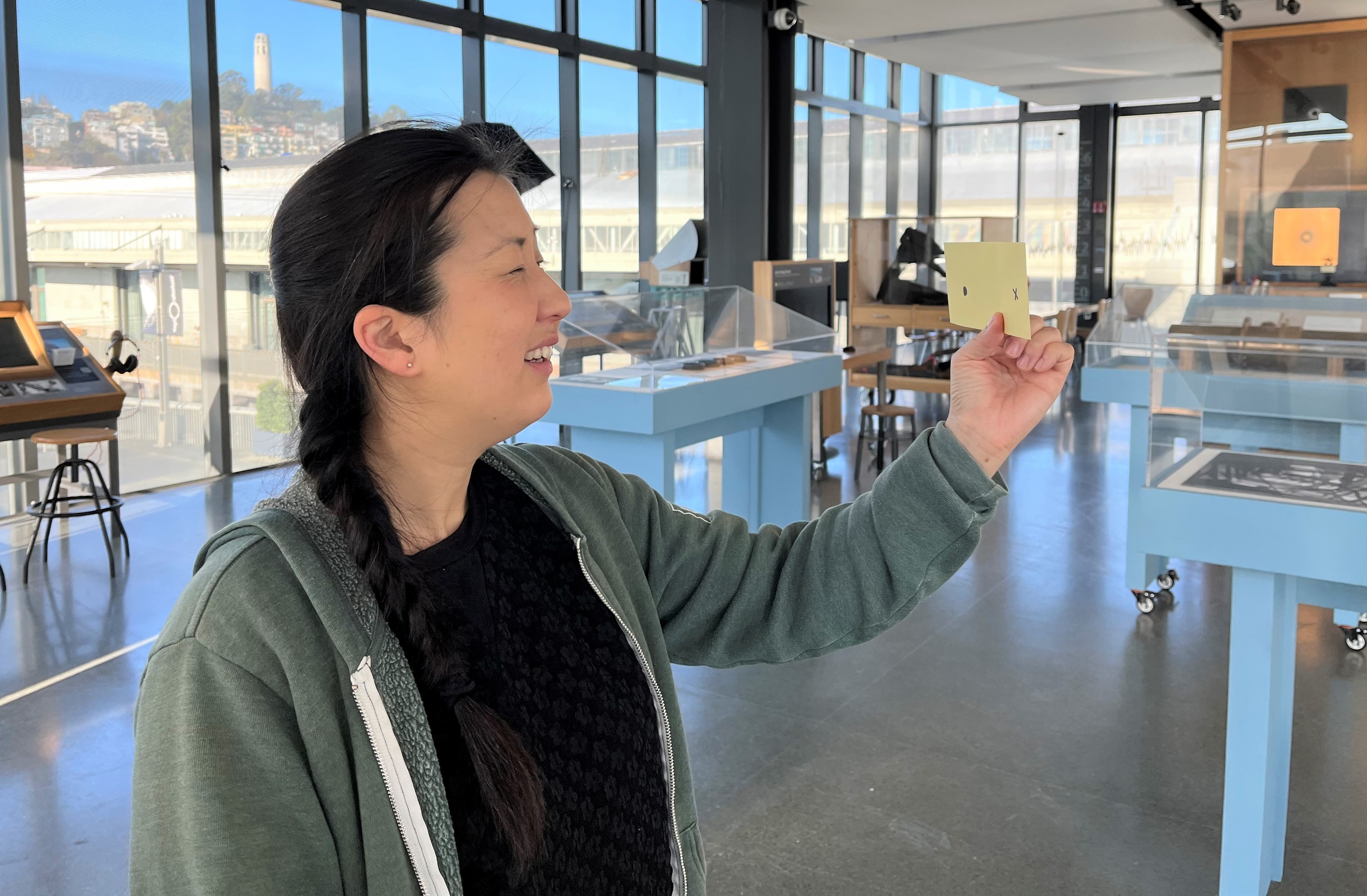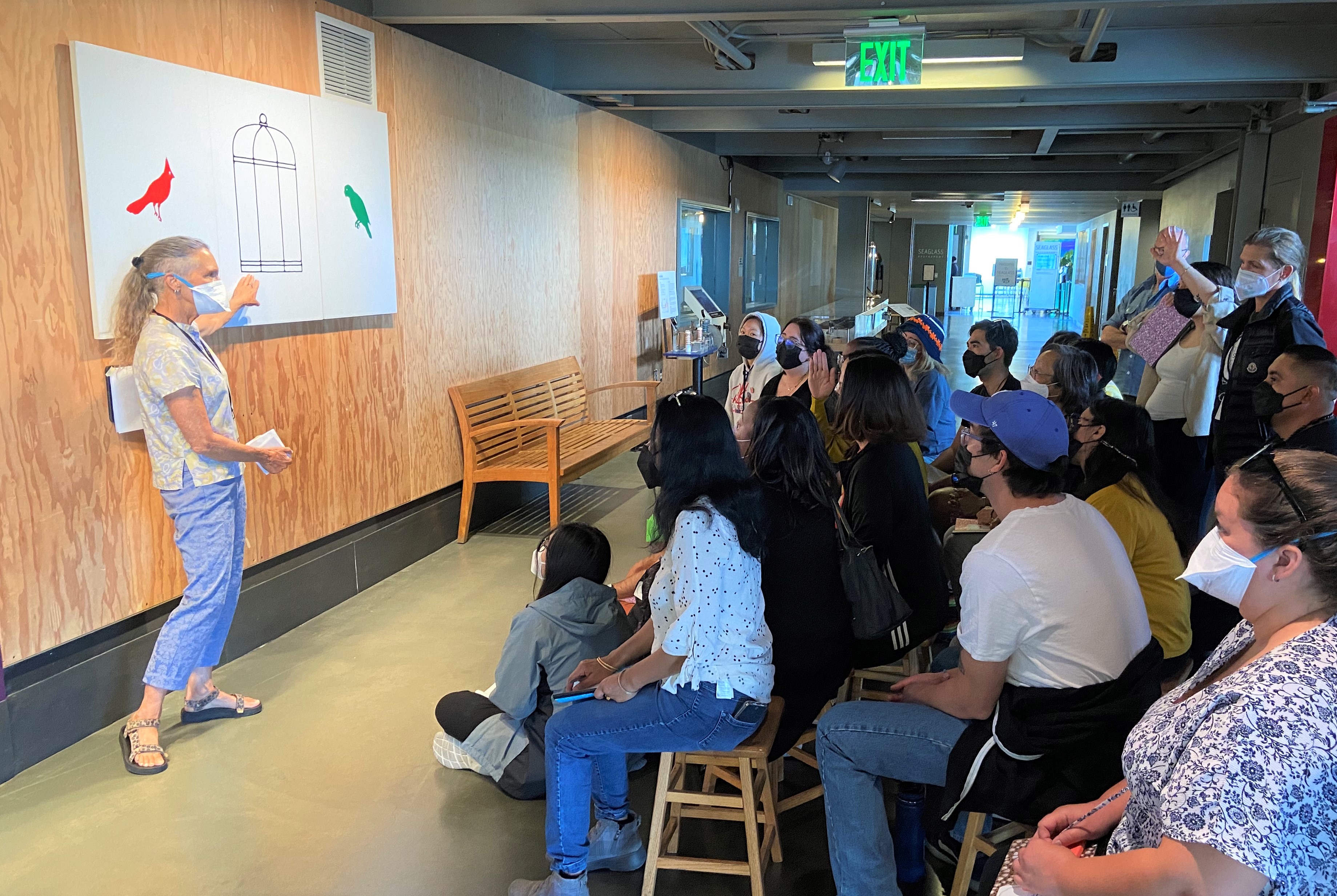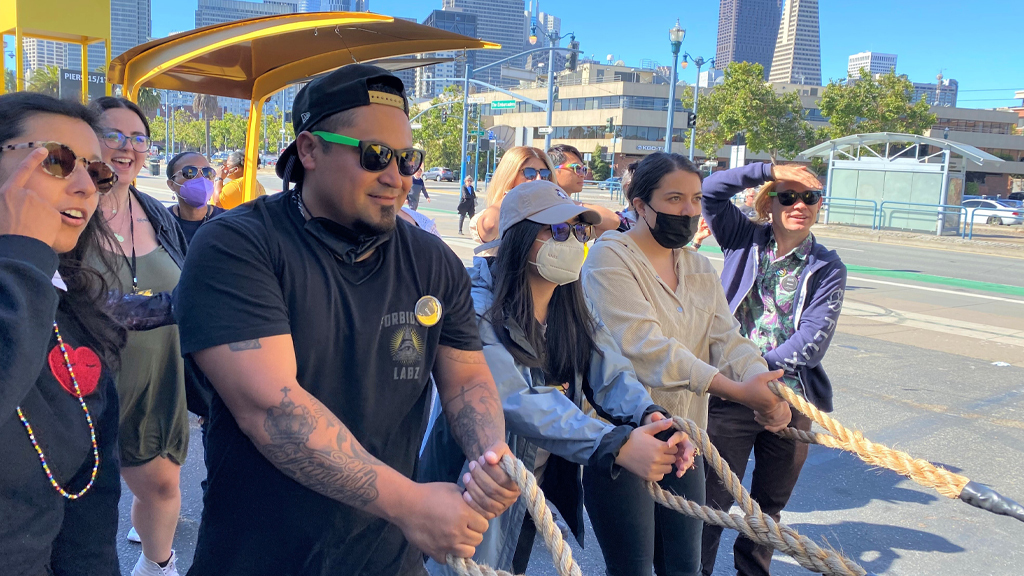Feature
Exploring Phenomena That Connect Science, Self, and Society
Phenomena-centered classrooms allow learners to use scientific practices to connect science content with meaningful experiences in their own lives, their communities, and society (Achieve et al. 2016). Further extending those connections to social phenomena can support a more equitable learning environment by reinforcing how our differences can impact our understanding of the world and how science does not act separately from society. This article describes three experiences in teacher professional development workshops at an informal science institution that begin with investigating a scientific phenomenon and then use that phenomenon for additional discussion of the impacts of diversity and social difference on individual, community, and societal levels.
Engaging in Phenomena as a Tool for Learning
These [phenomena-based] activities surface the invisible assumptions and prior knowledge we bring to how we might make sense of something, and lift up alternative frameworks that are the product of the same kind of cognitive sensemaking, but for different purposes, places, and cultural contexts. —Science Teacher Leader
Engaging in natural phenomena to understand disciplinary core ideas and cross-cutting concepts is a fundamental component of the Next Generation Science Standards (NGSS Lead States 2013). Learners develop understanding based on evidence and analyses they have conducted themselves using science and engineering practices. Through these experiences, students can use the process of science to understand the physical world around them. The NGSS also describe a vision for equity and diversity in science classrooms that emphasize making science accessible for all students, particularly those from non-dominant groups (NGSS Lead States 2013). Resources to help teachers and professional learning providers fulfill this vision often focus on vignettes and examples of how to attend to the needs of specific student groups (Lee et al. 2015). To create an equitable learning environment, teachers must consider the specific assets, experiences, perspectives, and needs of any learner population. They must also consider how classroom learning experiences support students to think about equity themselves.
We propose that phenomena-based science learning can provide opportunities for learners to reflect on their roles and participation in different social phenomena, thus better equipping them to address issues related to equity and diversity as members of society. When learners engage with a phenomenon together, they have a shared experience that provides a reference point for learning, rather than relying solely on individuals’ prior knowledge or vocabulary. This shared experience can be leveraged not only for science learning, but also for learning related to how individuals interact with each other and society on social levels. Reflecting on how scientific phenomena in the natural world relate to social phenomena can be powerful both in science classrooms with students as well as in professional learning settings with science teachers. Professional learning can thus be designed to not only support teachers to work with students more equitably but also model how to engage students directly in conversations about equity.
Professional learning in informal science institutions
That was really kind of cool to be able to walk out of our little room and then go to an actual exhibit that was this phenomenon that we were using to really engage in science learning. Because in the classroom that's really hard to do. You can't just walk out like, bam, there's the phenomenon right there for kids to see and engage with. You have to kind of plan for that. And so that was really kind of cool. —Science Coach and Former Biology and Environmental Studies Teacher
Informal science institutions (ISIs) have long been valued for their role in providing opportunities for learners to engage in scientific phenomena (NRC 2009). In addition to supporting student learning on field trips, ISIs can use their designed spaces to support teacher learning in professional development (PD) programs (Phillips et al. 2007; NASEM 2015). Teachers have reported that museum-based PD programs are often more productive and informative than other opportunities, highlighting the importance of access to science expertise and resources, other science teachers, and opportunities to engage with science in inquiry-rich ways through exhibits (Melber and Cox-Peterson 2005). A key characteristic of PD in ISIs is engaging teachers in active science learning where they ask questions, plan and carry out investigations, and connect observations to natural phenomena (Astor-Jack et al. 2006).
The Exploratorium Teacher Institute is an ISI-based professional home for secondary science teachers and leaders that uses inquiry-rich experiences to connect the teaching and learning of science to human identity, experience, and joy. Programs are designed to support educators throughout their professional learning journey and focus on science content and pedagogy, leadership, and justice-centered science teaching and learning. Active learning experiences are an essential component across all offerings. In addition to supporting teachers’ own science learning, these experiences support teachers to reflect on their own pedagogy and classroom contexts in a choice-based, non-evaluative environment (Heredia and Yu 2017). This video shares teacher participant and professional learning staff reflections on the value of directly engaging in phenomena for both students in the classroom as well as for teachers as part of their professional learning. These phenomena-based experiences serve as bases for deeper learning about science and society.
Below we offer three examples that illustrate how different scientific phenomena can serve as foundations for exploring science content as well as social phenomena at the individual, community, and societal level. These examples are each from workshops with science teachers and science teacher leaders at the middle and high school level. All quotations in this article are from participant interviews or anonymous feedback surveys conducted after their PD experience.
Phenomena as Metaphors for Individual Social Awareness
There are physical blind spots, but we also have social blind spots. And these things are innate in us, and the difference with a social blind spot versus a physical one is you can't get rid of your physical blind spot. But you can address your social blind spot…. It was awesome because it's this weaving of a STEM phenomena with this diversity, equity, inclusion, or social justice … which has been where I've been trying to go as an educator. I’m taking whatever I can, and then connecting it to a discipline that is relevant to our students … in a way that's social. —Seventh-Grade Science Teacher and Leader
Confronting evidence that we have made up something that does not exist provides an opportunity to reflect on our own assumptions and biases. Activities related to human perception often explore the science behind a perceptual organ and the brain and how our brains can come to a conclusion that is different from what is actually there. Visual illusions are an example of this. Because they reveal how our brain can make incorrect assumptions with incomplete or conflicting information, these phenomena can serve as social metaphors for how our individual perceptions of the world do not always match with reality.
Science Snacks are inquiry-rich, teacher-tested activities that explore physical phenomena using readily available, inexpensive materials. The Blind Spot Science Snack is a classroom activity that engages students in the phenomenon of their blind spot, a portion of the retina that does not contain light-detecting cells. Students hold a card with a marking on it that seems to disappear when held in a certain position in relation to their eye. Light reflects off the card into the viewer’s eye and onto their retina. If light from the marking aligns with the viewer’s blind spot, their brain will not receive that information and will make an inference based on the surrounding information, as it will not be able to detect what is actually there. This phenomenon provides experiential evidence that our brains—without our active effort or realization—will often fill in gaps for what we don’t know. This is a metaphor for our social blind spots and how we might make incorrect inferences about things we haven’t seen or experienced. The neuroscience behind the visual and social phenomena is different, but the simple use of the same phrase “blind spot” highlights how our knowledge—or what we think we know—is rooted in our individual experiences and may be incomplete.

The use of this activity as a social metaphor was developed as part of a program to support science teacher leaders working in communities of practice. Participants worked in groups throughout the academic year to address a shared problem of practice related to their leadership work in supporting science teachers (Heredia et al. 2022). One group focused on culturally responsive science teaching regularly engaged as learners in classroom activities that explored scientific phenomena. Committing time to these learning experiences grounded the group in their shared identities as science educators committed to high-quality science instruction. This allowed the group to use science learning experiences to further their work as teacher leaders in equitable science instruction, important work that is often dissociated from science content. Starting with a scientific phenomenon that furthered an understanding of our natural world led the group into more challenging discussions of the phenomena in our social world.
Phenomena to Build a Scientific Community
The way they did it, it was inclusive to all different people. And the way they performed it, you could include everybody in the discussion because you can come with your perspective to the phenomenon, and it is not necessarily wrong. You have to have an answer right then, and everybody could start with… everybody had some thoughts on it, so it was very inclusive. —Seventh-Grade Science Teacher
The practice of science relies on the collective effort of many individuals contributing and collaborating to create a greater overall understanding. In our work, we often use the term scientific community to describe teachers learning together in a PD setting or students in a classroom. Actively demonstrating how everyone’s contributions—and specifically the diversity of those contributions—lead to a better overall outcome can help learners think about their role and responsibilities in community. Because of individual differences, learners often have a variety of experiences when engaging in phenomena related to the science of human perception. If prompts ask specifically about each person’s experience, everyone can have a correct and potentially different answer. By engaging in an activity where different experiences lead to a deeper understanding of the overall phenomenon, the group is able to take advantage of and benefit from differences rather than be hindered by them. We use these activities to introduce the concept of building a scientific community, where the group’s collective understanding is strengthened by each individual contribution.
The Bird in a Cage Science Snack is a classroom activity that engages students in the phenomenon of visual afterimages. Learners stare at a brightly colored image and then at a plain white background. Upon switching their gaze, most people briefly perceive an image on the white background even though there is not one. This activity is an example of a classic science lesson that can be adapted from a prescriptive experience to a science practice–rich investigation suitable for an NGSS classroom (Heredia et al. 2016). In addition to investigating phenomena related to light, color, and the eye, we often engage a group of learners in an additional line of inquiry related to the motion of the afterimage. It is very common that participants will have different experiences of whether or not the afterimage moves and if so, in what direction. Participants create groups with people who saw something different and design experiments to understand their different experiences of the phenomenon. In addition to providing an engaging way to explore the science of the eye, centering the learning and collaboration around a phenomenon that can be experienced repeatedly creates a shared basis for community building and experimentation and provides a model for how science is truly practiced.

We often use this investigation at the beginning of multiday professional development workshops for several reasons. It is a phenomenon that we can all experience together that has cross-curricular ties to physical and life science content. It allows for quick and repeatable investigations for participants to pursue their own lines of inquiry. All of those results can be combined to develop a deeper understanding of the phenomenon, modeling the value of diversity in a scientific community. In this example, we are highlighting the processes of science rather than the specific scientific phenomenon to engage learners in thinking about how areas beyond science can also benefit from considering the multiple perspectives of one’s community.
Phenomena That Connect Science to Society
Support with identifying phenomena that allow for critical analysis of racism will help teachers bring some of these ideas into their lessons without it being an extra, on-the-side sort of thing. Similarly, phenomena that celebrate different races and cultures can also be included. —Science Teacher Leader
Students and teachers are actively engaged in the social phenomena of society, and many of the teachers in our community are interested in integrating discussions of equity, race, and social justice into their science classrooms. Science is sometimes framed as objective and separate from these issues, and a closer inspection of human influence on the practices and uses of science could surface how and where human biases impact scientific objectivity. Students and teachers can use the practices of science to reflect on social impacts by engaging in phenomena, collecting data, and discussing what claims can and cannot be made from that evidence.
The topic of humans and human variation is covered in biology and life science classes, and genetics and evolution are a natural, yet challenging, way to engage in discussions of whether different human experiences have scientific bases. Biologists largely agree that there is no biological basis for racial groups, yet we all experience the impacts of racial groupings in society (Donovan et al. 2019). Skin color is intimately connected to social constructions of race, and scientific inquiry can be used to learn about the source of skin color differences.

The Color Me Human Science Snack asks students to explore the phenomenon of different human skin tones and consider the factors from genetics and the environment that might impact those skin tones. This activity was developed for a life science workshop that explored the biological and environmental factors that influence human variation. The traits society often links to race are nearly all complex, and human variation in these traits, such as skin color, occurs along a continuum that does not show many natural divisions. This activity can serve as a way to discuss whether race is a meaningful and scientific way to describe human variation. Though conversations about race can be challenging, this phenomenon supports students in using evidence to see why racial divisions are not "natural" or biological, which can reduce racist and essentialist beliefs (Donovan et al. 2019). This provides an example of how science can be (mis)used to create social constructs that permeate society.
Closing
How do we represent science in class in ways that honor the brilliance of sensemaking and problem-solving shared by all peoples, at all times and places? When is it useful to surface ways that science is part of something fundamentally human that extends to other ways of knowing … as well as acknowledging that (current Western) science is a way of knowing that has some distinctive features and purposes when compared to other sensemaking systems? —Science Teacher Leader
Framing science learning around phenomena offers the opportunity to make direct connections between disciplinary core ideas and students’ own lives, supporting their understanding of the relevance of science and how it is useful in society (Achieve et al. 2016). The examples above offer three ways to also connect the exploration of science phenomena to discussions of social phenomena. We believe these conversations are critical to supporting an equitable learning environment for both students and teachers, whether you are a teacher yourself or a professional learning provider. These examples are from our work with teachers engaged in PD in an informal science setting. This setting primes learners to engage in the content with curiosity and in a non-evaluative way. It also allows teachers to consider how they might create similarly open-ended expectations for learning, and participants have reported using each of these activities with students in their classrooms. If the phenomena and extensions discussed here relate to your teaching context, more information about each activity can be accessed through the links provided. Whether or not you use these specific activities, we hope they provide ideas for engaging in phenomena that connect science, individuals, and society. We encourage you to consider how the phenomena that you use with your learners might be leveraged for discussions of how science relates to social behaviors and how we interact with each other on individual, community, and societal levels.
Acknowledgments
We thank the teacher participants and staff of the Exploratorium Teacher Institute for their contribution and dedication to this work.
This material is based upon work supported by the National Science Foundation under Grant No. 1907460. Any opinions, findings, and conclusions or recommendations expressed in this material are those of the authors and do not necessarily reflect the views of the National Science Foundation.
Julie H. Yu is a Senior Scientist and Michelle L. Phillips is a Senior Researcher, both at the Exploratorium in San Francisco, California.
citation: Yu, J.H., and M.L. Phillips. 2023. Exploring phenomena that connect science, self, and society. Connected Science Learning 5 (2). https://www.nsta.org/connected-science-learning/connected-science-learning-april-2023/exploring-phenomena-connect
Equity Phenomena Professional Learning Science and Engineering Practices Teaching Strategies Informal Education



